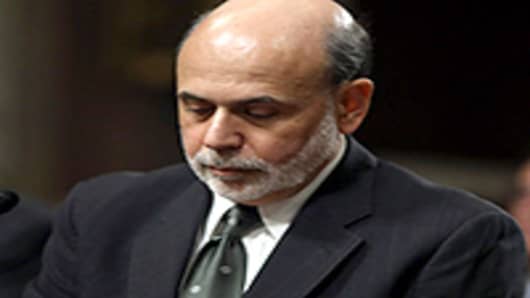While some Washington leaders demanded Tuesday that the Federal Reserve come through with more stimulus, the reality could be that it has run out of ways it can help.
Fed Chairman Ben Bernankegave his annual address to Congress on Tuesday and encouraged lawmakers to resolve their fiscal differences.
Instead, he faced challenges from some — in particular New York Democrat Charles Schumer — who want more central bank action. Schumer called the Fed"the only game in town" because of Washington gridlock and urged Bernanke to "get to work."
But with the Fed already holding interest rates near zero, American corporations and banks awash in cash and the central bank's balance sheet near $3 trillion, the Capitol Hill stalemate over deficit reduction looms as the economy's much bigger obstacle.
"Nothing is being done to promote the real economy and that's the real issue," Mohamed El-Erian, CEO at bond giant Pimco, told CNBC's "Squawk Box" program. "I feel sorry for Bernanke because the data is telling him he should be more active but there's a recognition that his policies are less effective."
Investors have thus been forced to face a twin threat — 1), that the Fed may not enact a third round of asset purchases known as quantitative easing, and 2) that even if it does, the move likely will provide no more than temporary relief to the wavering economy.
"This is really important for the markets," El-Erian said. "The market should not bet on an outcome that the Fed cannot deliver on its own."
Yet there were traders Tuesday, ignoring a decent round of morning earnings reports and a blowout surge in sentiment from the National Home Builders Association.
The stock marketsurged at the open then plunged as soon as Bernanke stepped to the microphone to deliver what used to be called the Fed chairman's "Humphrey Hawkins" address. Bernanke's remarks contained more concern about economic growth, particularly in housing and employment, but nary a word about more Fed intervention.
The market turned higherheading into the afternoon, helped by Bernanke's later comments that some traders thought suggested more stimulus.
"We liken it to drug therapy, where clients are put into remission," says Quincy Krosby, chief market strategist at Prudential Annuities in Newark, N.J. "But people know that at some point your body starts to reject the therapy and you're always hoping there's another drug and another innovation that keeps you going until they find a cure."
The trouble is, there's only so much chemotherapy and radiation a body can take.
"Bernanke has talked about the stock market as the transmission mechanism for monetary policy. It helps breed confidence and confidence breeds more confidence," Krosby says. "But the stock market is up. So this is where the dilemma is...because he knows that there are structural elements that are still impeding growth."
More maddening for QE opponents is that the data generally is hinting at an economy that is showing some signs of growth but continually running into political roadblocks impeding the way.
All of that excess liquidity in the economy also could lead to inflation, which would be exacerbated by more QE.
"The question in my mind is, is he not stepping up with another program in any quick fashion because they're starting to wonder if it's going to have any impact? Alternatively, are they not stepping up because when they look at the data they think, 'It's not that bad,'?" says Jim Paulsen, chief market strategist at Wells Capital Management in Minneapolis. "Maybe it's some of both. But does anyone need any more excess bank reserves?"
In the meantime, sentiment about the economy and its burgeoning debt and deficit problems continues to worsen.
The U.S. has seen a 50 percent increase in national debt over the past several years and the budget deficit is near $1.2 trillion, but growth for the most recent quarter is at just 1.9 percent.
Bank of America Merrill Lynch, spurred by Monday's dismal retail salesreport, cut its second quarter growth outlook to 1.1 percent — barely above a recession level and bracing for fallout from inaction in Washington.
"It's up to financial leaders to take some bold action. That's why Bernanke is continuing to stress the importance of dealing with the fiscal cliff by the end of the year," says Michelle Meyer, BofA's senior U.S. economist. "Given the election, given how partisan politics has become, it's likely to be pretty difficult, quite a challenge, to get some really concrete action, which is why it comes back to the Fed."
The Fed's worst nightmare, though, looms.
What if Bernanke does greenlight QE3, only to find that the action does little to spur growth? The Fed's most recent measure — Operation Twist, in which it bought short-term debt and sold longer-dated securities in a nearly equal amount — did little to assuage fears of another recession.
"The Fed is in a much weaker position than it publicly admits and most investors believe," Charles Biderman, CEO at market data firm TrimTabs, wrote in his weekly analysis. "With interest rates already at rock-bottom levels, all the Fed can do now is try to create a 'wealth effect' from artificially high asset prices, which is an extremely weak and indirect way to stimulate the economy."
Biderman predicts the future could be dour, even with more easing.
"If the Fed announces QE3, will it have even less of an impact than Operation Twist?" he said. "If so, we think the S&P 500 is vulnerable to a retracement all the way back down to the March 2009 lows."



